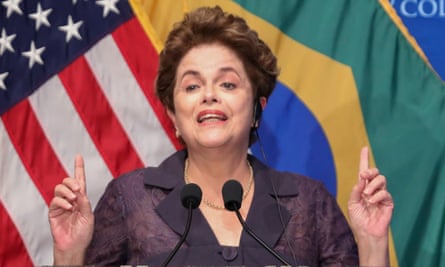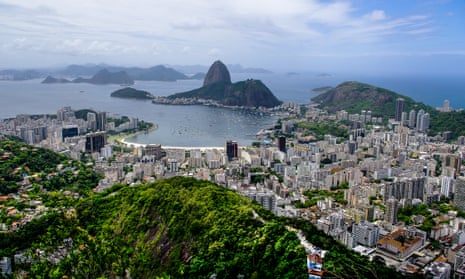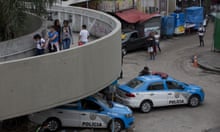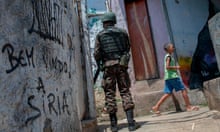It was the merest of glimpses, but no less thrilling for that. A dark, sleek body, roughly the size of a person, arched elegantly out of the Tapajós river as we approached the São Luis rapids deep in the Amazon. A fraction of a second later, it plunged back below the swirling waters, leaving me wondering if my imagination or the morning mist were playing tricks. But no, it was real. It had been close enough to the boat to be sure of that. But what was it?

Perhaps a pirarucu (AKA arapaima), the giant of the Amazon, which can grow up to 10ft in length. But the lack of scales suggested it was more likely to be a dolphin. There were two species in these waters: the pink boto and the darker tucuxi. I concluded it was the latter.
The thought filled me with both hope and dread. Eleven years earlier – during my previous post as China correspondent – I had joined an international team of scientists on an expedition along the Yangtze river looking for the baiji freshwater dolphin. It was too late. Not one could be found. The animal was declared functionally extinct – a victim of industrial pollution, river traffic, overfishing and hydroelectric dams. After 20m years of existence, it was an alarming indication of a dying river. Yet here in Brazil on the Tapajós, the freshwater dolphins – albeit of a different genus – could be found without searching. There was still time to save them. It felt like a second chance.
One of the reasons I moved from China to Brazil to become Latin America correspondent in 2012 was to look for a more sustainable development model. Back then, Brazil seemed to be doing a lot of things right. Its booming economy had just overtaken that of the UK; the popular leftwing government was reducing inequality; deforestation of the Amazon was slowing; Brazilian negotiators had played a positive role in climate and biodiversity negotiations; and my new home of Rio de Janeiro was about to host the 2012 Rio +20 Earth Summit, the 2014 World Cup final and the 2016 Olympic Games. Besides, I told my teenage daughters, who were doubtful about leaving Beijing, there would be less smog, more blue skies and a warm and friendly vibe. We were all in for a shock.
Adjustment was tougher than I expected. The differences were so vast. On the plus side, I grinned just to walk along the street and take in the views of what is surely among the most beautiful cities on the planet. My daily jog around the Lagoa took in the sights of the Christ the Redeemer statue, forested hillsides, the Rocinha favela, the peaks of Pedra da Gavea, Pedra Bonita and Dois Irmãos. I also saw more species of trees, birds, insects and mammals on those 7.4km (4.6-mile) runs than I would see in a whole year in Beijing. Similarly, I heard more good live music in my first week in Rio than perhaps my entire nine years in China.
After the communist states of east Asia, the openness and accessibility of democratic Latin American leaders was also a welcome shock. Having spent years in usually fruitless applications to interview ministers and heads of state in China and North Korea, I came to my new post in Brazil with a target list of three prominent politicians that I would like to meet during my first year – Dilma Rousseff, Marina Silva and Alfredo Sirkis. Within a week, I had seen all of them either in press conferences or for lunch. As I was later to learn, getting politicians in this part of the world to talk is often less of a problem than getting them to stop.

Other initial comparisons were less favourable. Cariocas (as residents of Rio call themselves) seemed far less focussed on education, culture, history, science and work than Beijingers. If they had spare time and money, many preferred to spend it on their body (tattoos, gyms or cosmetic surgery) so they could look good on the beach. And, contrary to the happy-go-lucky party-people image, they could be extremely conservative. One time, I was denied entry to a press conference I was supposed to be moderating because I failed to meet the dress code (although admittedly flower-patterned shorts and flip-flops weren’t the ideal match for my dress shirt). They also voted repeatedly for several of the country’s most rightwing politicians and some took to the streets calling for a return to the 1964-85 military dictatorship.
In those early days, however, I was mainly frustrated. Everything felt unambitious, slow and unreliable compared with China. Was it necessary to have three different types of plug socket? Why on earth did I have to keep providing my mother’s birth name for the most routine applications? The grotesque bureaucracy was not my only grumble. The notorious inequality was quickly evident, as was the enduring social legacy of what had been the world’s biggest slave-trading nation. Apart from music, cultural life seemed poor and the food was bland compared with Asia. Property rental was absurdly complicated and the apartments were horrendously overpriced due to the country’s then super-strong currency (Brazil was infamous at the time for selling the world’s most expensive iPhones). I spent much of the first year sleeping in a mouldy shed that leaked in tropical rainstorms, obliging me to have a bucket by the pillow to catch the drops.
More importantly, it became apparent that I had been sold an overhyped image of Brazil. Far from being a new model, the past five years have proved a case study in how not to run a country.
This has been a spectacularly tumultuous period, encompassing the impeachment of a president, the worst economic contraction in 100 years, the biggest corruption scandal in the country’s history, millions taking to the streets in protest, an unimaginable 1-7 defeat in the World Cup, a pre-Olympic Zika epidemic and a resurgence of violent crime and environmental destruction. My Brazilian journalist friends are not sure whether to feel grateful for the abundance of work or horrified at the flood of miserable stories. “We’ve had 40 years of news packed into the last four years,” observed one. “It’s surreal. We seem to be reporting on the collapse of the republic,” lamented another. It is impossible not to feel sorry for the country.
Brazil has slipped into reverse gear on just about every front. Since 2012, the economy has shrunk by 9% and unemployment has almost doubled. Last year, deforestation of the Amazon accelerated by 29% and violent killings in Rio de Janeiro increased by almost 30%. Not surprisingly, the public has never been more frustrated with the government. Five years ago, the then-president Dilma Rousseff enjoyed approval ratings of 64%. That had fallen to 10% when she was politically lynched by her former allies last year. Her successor, Michel Temer, is even more unpopular. The most recent poll could find only 2% of voters who thought he was doing a good job.

In some ways, the story of Brazil from 2012 to 2017 has been the inverse of China from 2003 to 2012. In Asia’s biggest country, I observed sometimes brutal stability and spectacular economic growth. In Latin America’s, I have witnessed turmoil and contraction. I have certainly inhaled a lot more teargas, particularly since the mass protests ahead of the 2013 Confederations Cup, which were a turning point.
Regionally, the broad political trend has been a weakening of populist, leftwing power. In the past five years, the two great figureheads of the Latin left – Fidel Castro and Hugo Chávez – have died. The Brazilian Workers party founder Luiz Inácio Lula da Silva has been put on trial and his party usurped from office by centre-right parties that have proved at least as corrupt. In Argentina, the formerly Perónist government of Cristina Fernández de Kirchner has been replaced by the more conservative Mauricio Macri. In Bolivia, Evo Morales lost a referendum that would have allowed him to stand again for re-election. Venezuela, meanwhile, plunges ever deeper into crisis under Nicolás Maduro. But Chile, Peru, Uruguay, Colombia, Ecuador, Nicaragua and Mexico are all exceptions in different ways. Latin American politics are too heterogenous for perfect generalisations.
A clearer pattern – and one perhaps that underlines the tumult both here and elsewhere in the world – is the increasing evidence of climate change across the region. Patagonian lakes are drying up and glaciers retreating; Rio’s beaches have been battered by record storm surges; Chile’s forests were devastated earlier this year by unprecedentedly high temperatures and wildfires; and then Lima was hit by freak floods. Perhaps the most alarming story, however, was São Paulo – the biggest city in Latin America – suffering the most prolonged drought in its history. I recall a dystopian moment when I was told there was no coffee at a Starbucks on Avenida Paulista – the city’s main thoroughfare – because the taps had run dry. “We only have beer or Coke,” the cashier said.
The destruction of the rainforest is making matters worse in ways that are only slowly being understood. But it often appears to be a bigger story overseas than in the media of Brazil and other Amazonian nations. As well as being a major source of carbon emissions and a threat to biodiversity, the loss of foliage is also eroding the forest’s role as a climate regulator. Recent studies have shown that the Amazon acts as a giant water pump, channelling moisture inland via aerial rivers and rainclouds that form over the forest more dramatically than over the sea. As trees are felled, this function is weakened, which leads to more severe droughts and more extreme weather events.

Yet, even as scientists grow more alarmed, politicians are becoming less willing to act. In response to demands from the agribusiness lobby (which has become more powerful due to demand from China), Rousseff relaxed the Forest Code, Brazil’s main law against illegal logging and land clearance. The current administration of Michel Temer has slashed the environment ministry budget, diluted licensing regulations, and is moving to reduce the size of conservation parks and indigenous territories. In Brazil and elsewhere in the region, activists who stand up against the loggers, farmers, miners and dam builders run the risk of beatings and murder – as I saw on an unforgettable trip to Lábrea. More often than not, those in the frontline are indigenous communities who are trying to protect their territory, such as the Juruna, the Ka’apor and the Mundruku and the Kichwa and Shuar. These days, the tribes wear T-shirts, ride motorbikes and use laptops, but they still often suffer the same fate as their ancestors when the first European settlers arrived – either driven off their land or murdered for resisting. Most prominent among them in this period was Berta Cáceres, an indigenous rights and environment activist in Honduras who won the Goldman prize in 2015 for her campaigns against deforestation and hydropower dams. In an email exchange at the time, she told me environmental protection was a cause worth fighting for. “We must undertake the struggle in all parts of the world, wherever we may be, because we have no other spare or replacement planet. We have only this one, and we have to take action,” she said. A year later she was assassinated by a gunman.
This is the world’s most murderous continent. In Central America, violence is the main driver for perilous child migration to the US, though it remains to be seen how this might be affected by the wall on the Mexican border being planned by the new caudilho in the White House.
Reporting here has its risks, though local journalists are far more exposed than foreign correspondents. The only time I saw a gang member fire a gun up close was after a visit to a crack den in the town of Lins, when I asked him why he had chosen his weapon. On a street in broad daylight, he squeezed a dozen or so rounds into the air that made me instantly regret my question. A few weeks later, police pushed his gang out of Lins in a “pacification” operation. I imagine they are back now. Thanks to a series of scandals and cuts in the police budget, the sound of gunfire is sadly becoming common again in Rio. Recently, I went to sleep three nights in a row listening to protracted shootouts echoing across the valley.
Apart from that, there were few hairy moments. The only crimes I experienced were having my credit card cloned three times and being pickpocketed. I was generally more worried about flying over the Andes (which often comes with gut-wrenching turbulence), the interruption of a dinner in Maranhão in north-eastern Brazil by an uninvited tarantula, and the possibility of diseases such as malaria, dengue and chikungunya. Zika was added to the list in 2016. Although my head told me the risks were mainly only to pregnant women, I could not help but feel a little unease – as well as irony – at being bitten by a mosquito during a press conference in which the head of the World Health Organization, Margaret Chan, explained why the Zika epidemic had just been declared a global emergency. The concerns were genuine, though the imminent Olympics meant the risks were overhyped. When the Brazilian government subsequently launched its biggest ever military operation against the tiny insect, it felt a little like something out of a science-fiction film.
In this continent of magical realism, the weird and wonderful were never far away. Evangelicals in a heavy-metal church in the Maré favela described visits by an angel in the form of a head-banger who would dance among them, shirtless with long hair, army boots, black trousers and chains. In the Andean mountains, I witnessed what looked at first like something out of an ancient myth: a beast with wings and horns charging down a matador. It was, in fact, a cruel and dangerous sport that involved stitching the talons of an endangered condor into the hide of a traumatised bull for the entertainment of a chicha-sodden crowd at a Yawar festival bullfight. Then there was a mass in the countryside of Rio by rebel anti-Vatican priests who insisted the pope was not Catholic enough. They preferred Vladimir Putin.
There have also been inspiring, uplifting stories: the end of the world’s oldest civil war in Colombia, the overcoming of cold war hostilities between Cuba and the United States and the subsequent visits to Havana by Pope Francis, Barack Obama and the Rolling Stones.
But when it comes to liberal, well-run countries, Uruguay led the way by legalising marijuana, ramping up renewable energy and boasting a former president, José Mujica, who lived his anti-consumerist values by eschewing a palace home for his charmingly ramshackle farmhouse.
Despite Brazil’s many woes, there was cause for hope in the success of Brazil’s bolsa familia poverty relief programme (though it is now threatened by austerity cuts), the courage and canninness of indigenous groups fighting against loggers, the idealism of activists and prosecutors fighting illegal deforestation and exposing timber laundering , and the courage and talent of community journalists who provided a diary of life in Rio’s favelas ahead of the Olympics.

I will miss this continent. It has been an immense privilege to visit stunningly beautiful places such as Patagonia, Alter do Chão, Machu Picchu, Yasuni and Havana, and I am grateful to collaborators and editors who have worked with me on stories ranging from guerrilla graffiti pedants in Quito and the world’s greatest vinyl collector in São Paulo, to the source-to-sewer journey of a drop of water in Mexico City and a retracing of part of a journey taken by the Edwardian explorer Percy Fawcett.
Although I could never claim to blend in (Chávez took one look at me and yelled out: “Hey, Gringo!”), I now think of Latin America as home (particularly since I moved out of the shed and into a forest apartment). I still don’t appreciate the three-plug electrical system or Brazil’s bureaucracy, but I have come to love the geniality of the people, the vibrancy of the markets and much of the food – especially açai, caldo de cana, tapioca wraps and Amazonian fish.
I leave at a difficult time. Troubles lie ahead for Rio, Brazil and the world. This is not just because of a poor Olympic legacy (though homelessness has surged alarmingly in the host city since the Games) or woeful national leadership (Temer is the first sitting president to be charged with corruption and eight of his cabinet are implicated in bribery scandals).
In China, I came to believe environmental crises underlie much of the economic and political tension in the world. In Latin America, I found reason to hope it is not too late to do something about that. For sure, the trends are bad. But there is much here worth fighting for. Latin America may not offer a model of sustainable development, but compared with Asia it is relatively unscarred in terms of overpopulation and pollution, and compared with the US and Europe, average consumption is modest and biodiversity is rich. River dolphins in the Amazon are only a part of that wealth. The value of this natural heritage is easier to feel than to measure
I will leave Brazil healthier and happier than I arrived. As I write this, the sun is streaming through the papaya and mango trees from a gloriously clear blue sky. It is midwinter, but the temperature is a balmy 25C. This morning, I cycled through the forest up to the Vista Chinesa viewpoint. Marmosets were waiting in the garden for food when I returned a couple of hours later. A hummingbird just flew into the living room looking for the nectar water that I forgot to leave at its usual spot by the window. Before I go, maybe I’ll catch a final glimpse of a toucan, a jacu or a porcupine. Perhaps the gang of capuchin will invade the kitchen in search of an egg or a banana. There will be at least one possum. Then – after 21 years on the road – it will be time to return to London, to a new job, to an office, to a flat, and to pigeons, sparrows and, who knows, perhaps a squirrel. I’m curious whether my old home will feel like a foreign country.








Comments (…)
Sign in or create your Guardian account to join the discussion